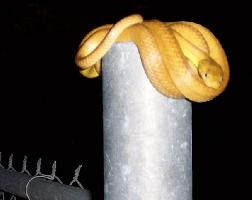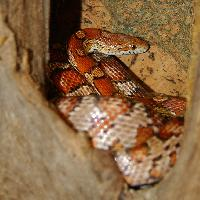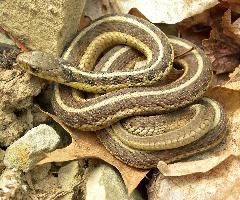
Poids et mesures
| Longueur | de 1 à 2 m |
|---|
Description de l'animal
The Brown Tree Snake, scientifically known as Boiga irregularis, is a fascinating and somewhat notorious species within the reptilian world, primarily due to its significant impact on the ecosystems it invades. This slender, arboreal snake hails from the coastal areas and forests of Australia, Papua New Guinea, and the Solomon Islands but has become infamous for its invasive and destructive presence on the island of Guam.Characterized by its variable coloration, which ranges from a reddish-brown to a more olive hue, the Brown Tree Snake is adept at blending into its surroundings. Adults can reach lengths of up to 2 meters (about 6.5 feet), although sizes around 1 to 1.5 meters are more common. The snake's body is elongated and slender, designed for a life spent primarily in trees. Its head is slightly distinct from the neck, and it possesses large, prominent eyes with vertical pupils, adaptations that hint at its nocturnal lifestyle.
The diet of the Brown Tree Snake is impressively diverse, showcasing the adaptability of this species. It preys on birds, small mammals, lizards, and frogs, using its rear-fanged venom to subdue its prey. While the venom is relatively mild and poses little threat to adult humans, it is effective against smaller prey species. This dietary flexibility has allowed the Brown Tree Snake to thrive in various environments, contributing to its success as an invasive species.
Reproduction in the Brown Tree Snake is oviparous, meaning the females lay eggs. A single clutch can contain anywhere from 4 to 12 eggs, with the female laying up to two clutches per year depending on environmental conditions. The eggs are typically laid in hidden or protected locations, ensuring the safety of the next generation until they are ready to hatch.
The introduction of the Brown Tree Snake to Guam post-World War II had devastating effects on the island's native bird populations. With no natural predators to keep its numbers in check, the snake's population exploded, leading to the decline or extinction of several bird species that were integral to Guam's ecosystem. This ecological disruption also had cascading effects, including increases in pest insects and damage to the island's power infrastructure due to the snakes climbing utility poles.
Efforts to control the population of the Brown Tree Snake on Guam and prevent its spread to other vulnerable ecosystems have included trapping, the use of snake-deterring fences, and the aerial dropping of poisoned bait. These measures, along with public education and strict cargo inspections, aim to mitigate the impact of this invasive species and protect biodiversity in affected regions.
In summary, the Brown Tree Snake is a species of great adaptability and resilience, traits that have enabled it to become a successful colonizer of new territories. However, its presence outside its native range has also highlighted the delicate balance of ecosystems and the potentially catastrophic consequences of introducing non-native species into foreign environments.
Animaux similaires
Nouvelles photos d'animaux
Top 10 des animaux
- Dolphin gull (Leucophaeus scoresbii)
- Japanese macaque (Macaca fuscata)
- Stone loach (Barbatula barbatula)
- Greek tortoise (Testudo graeca)
- Russian tortoise (Testudo horsfieldii)
- Galápagos tortoise (Geochelone nigra complex)
- Diana monkey (Cercopithecus diana)
- Moustached guenon (Cercopithecus cephus)
- Common flying dragon (Draco volans)
- Galápagos penguin (Spheniscus mendiculus)


